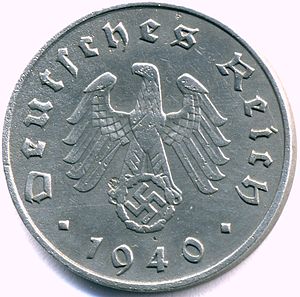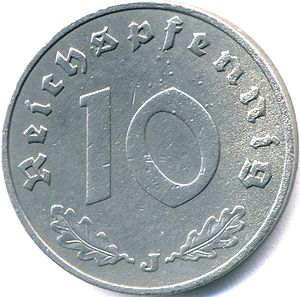Reich credit treasury note
| Reichsmark | |||||
|---|---|---|---|---|---|
|
|||||
| Denominations | |||||
| Subunit | |||||
| 1⁄100 | Reichspfennig | ||||
| Plural | Reichsmark | ||||
| Reichspfennig | Reichspfennig | ||||
| Symbol | ℛℳ | ||||
| Banknotes | 5 ℛℳ, 10 ℛℳ, 20 ℛℳ, 50 ℛℳ, 100 ℛℳ, 1000 ℛℳ | ||||
| Coins | 1 rpf, 2 rpf, 5 rpf, 10 rpf, 50 rpf, 1 ℛℳ, 2 ℛℳ, 5 ℛℳ | ||||
| Demographics | |||||
| User(s) |
|
||||
| Issuance | |||||
| Central bank | Reichsbank | ||||
| Valuation | |||||
| Pegged by | Belgian franc, Bohemian and Moravian koruna, Bulgarian lev, Danish krone, French franc, Italian lira, Luxembourg franc, Dutch gulden, Norwegian krone, Polish złoty, Serbian dinar, Slovak koruna, Ukrainian karbovanets in World War II as similar rates | ||||
|
This infobox shows the latest status before this currency was rendered obsolete.
|
|||||
| Value | 10 Reichspfennig |
|---|---|
| Mass | 3.52 g |
| Diameter | 21 mm |
| Thickness | 1.5 mm |
| Edge | Plain |
| Composition | 100% Zn |
| Years of minting | 1940-1945 |
| Obverse | |
 |
|
| Design |
Reichsadler with swastika. Lettering: Deutsches Reich 1940 |
| Reverse | |
 |
|
| Design |
Denomination and two oak leaves. Mintmark below the denomination and between leaves. Lettering: 10 Reichspfennig J |
The Reichsmark (German: [ˈʁaɪçsˌmaʁk]; sign: ℛℳ) was the currency in Germany from 1924 until 20 June 1948 in West Germany, where it was replaced with the Deutsche Mark, and until the 23 June in East Germany when it was replaced by the East German mark. The Reichsmark was subdivided into 100 Reichspfennig. The Mark is an ancient Germanic weight measure, traditionally a half pound, later used for several coins. From 1871 to 1918 Germany was called the Kaiserreich, or the Deutsches Reich. Although Germany became a republic in 1918, the term "Reich" remained part of the country's official name.
The Reichsmark was introduced in 1924 as a permanent replacement for the Papiermark. This was necessary due to the 1920s German inflation which had reached its peak in 1923. The exchange rate between the old Papiermark and the Reichsmark was 1 ℛℳ = 1012 Papiermark (one trillion in US English and French, one billion in German and other European languages and UK English of the time, see long and short scales). To stabilize the economy and to smooth the transition, the Papiermark was not directly replaced by the Reichsmark, but by the Rentenmark, an interim currency backed by the Deutsche Rentenbank, owning industrial and agricultural real estate assets. The Reichsmark was put on the gold standard at the rate previously used by the Goldmark, with the U.S. dollar worth 4.2 ℛℳ.
A number of companies were created with inadequate capital for their operations and authorized to issue bonds exchangeable at a 1:1 rate for Reichsmarks and sold at a discount. The Reichsbank rediscounted the bills of these companies creating a monetary expansion without formally renouncing the link to gold.
...
Wikipedia


